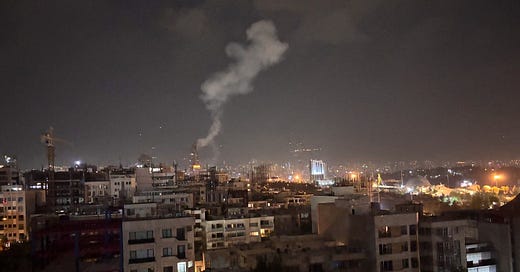Why Iran doesn’t actually want war with Israel
Despite claims to the contrary, the current geopolitical odds are not in the Iranians' favor.
Since Israel’s unprecedented strikes against Iran last Friday, the Islamic Republic has retaliated with a series of missile and drone attacks, prompting further Israeli responses.
In the days since, the two sides have engaged in what increasingly resembles a war of attrition—launching as many attacks as possible until one of the belligerents is exhausted of military resources.
So far, Israel has struck several key targets across Iran. Most recently, it hit the headquarters of the state-controlled Islamic Republic of Iran Broadcasting (IRIB), forcing it to cease programming. Israel also confirmed it targeted the Quds Force’s headquarters, a key branch of the Islamic Revolutionary Guard Corps. Additionally, several Iranian energy facilities, such as the Fajr-e Jam refinery, were hit.
Amid the escalating conflict, Iran has issued threats not only against Israel but also the United States. Iran’s defense minister, for instance, warned against American involvement in the conflict, threatening to strike U.S. bases across the region.
Iranian allies in the Middle East have echoed these threats. Kataib Hezbollah, an Iraqi Shiite militia closely aligned with Iran, warned the U.S. not to intervene in the conflict between Tel Aviv and Tehran, stating it would target American bases in Iraq.
Despite these threats, the Islamic Republic appears to have little appetite for a full-scale war. If it did, it likely would not have engaged in nuclear talks with the Trump administration throughout the year.
Rather, Iran’s threats are largely posturing—smoke screens meant to project strength in the face of adversity. Yet Israel’s assault has exposed the regime’s vulnerability, a weakness that Iran’s leadership is undoubtedly aware of.
For decades, the so-called "Axis of Resistance"—a loose coalition of states and militias across the Middle East aligned with Iran—has helped prop up the Islamic Republic.
Through Hezbollah and Hamas, Iran maintained a strategic foothold in the Levant, encircling Israel and ensuring that the threat from Tehran loomed large over Tel Aviv.
However, in the span of a year, the Axis has never looked shakier.
Hezbollah has long been Iran’s premier proxy group. Prior to its 2024 conflict with Israel, it was reported to have more than 50,000 fighters and a vast arsenal of rockets and missiles—estimated between 120,000 and 200,000.
This formidable strength, achieved through sustained Iranian support, made Hezbollah one of the world’s most powerful non-state armed actors.
Notably, the September pager attacks decapitated much of Hezbollah’s leadership. Its longtime leader, Hassan Nasrallah, was assassinated in an Israeli strike on Beirut on September 27.
Hezbollah once served as Iran’s first line of defense against threats from Israel and the broader Levant, particularly those targeting Tehran’s nuclear infrastructure. But with the group now significantly weakened, Iran’s regional buffer has eroded.
Similarly, Hamas has been severely degraded by the war in Gaza. In a June 2024 report, Bruce Hoffman of the Council on Foreign Relations estimated Hamas had lost roughly half its fighters since the onset of the conflict.
Israel has also targeted Hamas’ extensive tunnel network, long used for smuggling weapons and launching guerrilla attacks. Though most of the tunnels remain intact, roughly a quarter were destroyed—a serious blow to a group that, as Hoffman notes, “depends on tunnels for its survival.”
Another key Iranian foothold in the Levant was Baathist Syria. Under President Bashar al-Assad, Syria hosted several Iranian proxies, including Hezbollah, and allowed Iran to transfer weapons through its territory.
However, Assad’s downfall in late 2024 marked a seismic shift in the Middle East's balance of power. His successor, President Ahmed al-Sharaa, has drifted closer to the Gulf states and even suggested the possibility of normalizing relations with Israel—something unthinkable under Assad’s Iran-aligned regime.
Although the Houthis remain in control of parts of Yemen and continue to attack Israel, their geographic distance limits their ability to defend Iran directly.
Combined with mounting domestic unrest, these factors underscore the regime’s growing vulnerability—especially in light of reports that Israel has considered assassinating Supreme Leader Ayatollah Ali Khamenei.
The Iranian leadership is acutely aware of its fragility relative to Israel—a country that has previously defeated the combined forces of multiple Arab states and emerged with expanded territorial holdings. In contrast, Iran’s war with Iraq in the 1980s ended in a costly and inconclusive stalemate, with no territorial gains.
While Tehran’s threats—particularly those targeting U.S. forces—must not be dismissed lightly, the Islamic Republic is clearly not ready for war now, or likely at any point in the near future.





